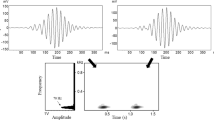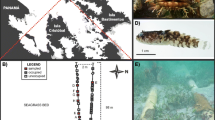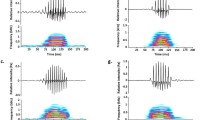Abstract
The “boatwhistle” calls of Sanopus astrifer and Batrachoides gilberti, two toadfish species from Belize, are described for the first time. These descriptions add to the small number of toadfish species sounds known to date (6 out of 79 species). Both Belize toadfishes produced multiple notes per call, unlike most other toadfish species which produce a single-note call (with the exception of Opsanus beta). S. astrifer produced significantly more notes per call than B. gilberti (p < .05), and was recorded producing up to 7 notes, the highest number of notes per call of any toadfish species reported. Differences in the boatwhistle call between all species with available data are reviewed and it is hypothesized that phylogenetic relationships, morphology of the swimbladder, and evolutionary processes are factors that potentially influenced these differences.






Similar content being viewed by others
References
Amorim MCP, Vasconcelos RO (2006) Individuality in the mating call of the male Lusitanian toadfish, Halobatrachus didactylus. Razprave IV r Sazu 47:237–244
Amorim MCP, Vasconcelos RO (2008) Variability in the mating calls of the Lusitanian toadfish Halobatrachus didactylus: cues for potential individual recognition. J Fish Biol 73:1267–1283
Amorim MCP, Stratoudakis Y, Hawkins AD (2004) Sound production during competitive feeding in the grey gurnard. J Fish Biol 65:182–194
Amorim MCP, Vasconcelos RO, Marques JF, Almada F (2006) Seasonal variation of sound production in the Lusitanian toadfish Halobatrachus didactylus. J Fish Biol 69:1892–1899
Amorim MCP, Simões JM, Mendonça N, Bandarra NM, Almada VC, Fonseca PJ (2010) Lusitanian toadfish song reflects male quality. J Exp Biol 213:2997–3004
Avise JC, Reeb CA, Saunders NC (1987) Geographic population structure and species differences in mitochondrial DNA of mouthbrooding marine catfishes (Ariidae) and demersal spawning toadfishes (Batrachoididae). Evolution 41:991–1002
Barimo JF, Fine ML (1998) Relationship of swim-bladder shape to the directionality of pattern of underwater sound in the oyster toadfish. Can J Zool 76:134–143
Bass AH, Baker R (1991) Evolution of homologous vocal control traits. Brain Behav Evol 38:240–254
Bass AH, Marchaterre MA (1989) Sound-generating (sonic) motor system in a teleost fish (Porichthys notatus): sexual polymorphism in the ultrastructure of myofibrils. J Comp Neurol 286:141–153
Bass AH, McKibben JR (2003) Neural mechanisms and behaviors for acoustic communication in teleost fish. Prog Neurobiol 69:1–26
Bass AH, Bodnar D, Marchaterre MA (1999) Complementary explanations for existing phenotypes in an acoustic communication system. In: Hauser MD, Konishi M (eds) The design of animal communication. MIT Press, Cambridge, pp 493–514
Beukers JS, Jones GP (1997) Habitat complexity modifies the impact of piscivores on a coral reef fish population. Oecologia 114:50–59
Brantley RK, Bass AH (1994) Alternative male spawning tactics and acoustic signals in the plainfin midshipman fish Porichthys notatus Girard (Teleostei, Batrachoididae). Ethology 96:213–232
Brumm H, Voss K, Kollmer I, Todt D (2004) Acoustic communication in noise: regulation of call characteristics in a New World monkey. J Exp Biol 207:443–448
Collette BB (2002) Order Batrachoidiformes, Batrachoididae, Toadfishes. In: Carpenter KE (ed) The living marine resources of the Western Central Atlantic. Volume 2: Bony fishes, part 1 (Acipenseridae to Grammatidae). FAO Species Identification Guide for Fishery Purposes and American Society of Ichthyologists and Herpetologists Special Publication No. 5. Rome, FAO. pp 601–1374
Collette BB, Russo JL (1981) A revision of the scaly toadfishes, genus Batrachoides, with descriptions of two new species from the Eastern Pacific. Bull Mar Sci 31:197–233
De Winter AJ (1995) Genetic control and evolution of acoustic signals in planthoppers (Homoptera: Delphacidae). Res Popul Ecol 37:99–104
dos Santos ME, Modesto T, Matos RJ, Grober MS, Oliveira RF, Canario A (2000) Sound production by the Lusitanian toadfish, Halobatrachus didactylus. Bioacoustics 11:309–321
Fänge R, Wittenberg JB (1958) The swimbladder of the toadfish (Opsanus tau L.). Biol Bull 115:172–179
Fine ML (1978) Seasonal and geographical variation of the mating call of the oyster toadfish Opsanus tau L. Oecologia 36:45–57
Fine ML (1981) Mismatch between sound production and hearing in the Oyster Toadfish. In: Tavolga WN, Popper AN, Fay RR (eds) Hearing and sound communication in fishes. Springer, New York, pp 257–263
Fine ML, Lenhardt ML (1983) Shallow-water propagation of the toadfish mating call. CompBiochem Physiol 76A:225–231
Fine ML, Thorson RF (2008) Use of passive acoustics for assessing behavioral interactions in individual toadfish. Trans Am Fish Soc 137:627–637
Fine ML, Winn HE, Olla BL (1977) Communication in fishes. In: Sebeok TA (ed) How animals communicate. Indiana UP, Bloomington, pp 472–518
Fine M, Malloy K, King C, Mitchell S, Cameron T (2001) Movement and sound generation by the toadfish swimbladder. J Comp Physiol A 187:371–379
Fish JF (1972) The effect of sound playback on the toadfish. In: Winn HE, Bolla BL (eds) Behavior of marine animals, vol 2. Plenum Press, New York, pp 386–434
Freshwater DW, Khyn-Hansen C, Sarver SK, Walsh PJ (2000) Phylogeny of Opsanus spp. (Batrachoididae) inferred from multiple mitochondrial-DNA sequences. Mar Biol 136:961–968
Gannon DP, Barros NB, Nowacek DP, Read AJ, Waples DM, Wells RS (2005) Prey detection by bottlenose dolphins, Tursiops truncatus: an experimental test of the passive listening hypothesis. Anim Behav 69:709–720
Gill TN (1907) Life histories of toadfishes (Batrachoidids), compared with those of weevers (Trachinids) and stargazers (Uranoscopids). Smithsonian Misc Coll 48:388–427
Gray G, Winn HE (1961) Reproductive ecology and sound production of the toadfish, Opsanus tau. Ecology 42:274–282
Greenfield DW, Thomerson JE (1997) Fishes of the continental waters of Belize. University Press of Florida, Florida, p 311
Greenfield DW, Winterbottom R, Collette BB (2008) Review of the toadfish genera (Teleostei: Batrachoididae). Proc Calif Acad Sci 59:665–710
Hawkins AD, Amorim MCP (2000) Spawning sounds of the male haddock, Melanogrammus aeglefinus. Environ Biol Fish 59:29–41
Ibara RM, Penny LT, Ebeling AW, van Dykhuizen G, Cailliet G (1983) The mating call of the plainfin midshipman fish, Porichthys notatus. In: Noakes DLG, Lindquist DG, Helfman GS, Ward JA (eds) Predators and prey in fishes. Dr W. Junk Publishers, The Hague, pp 205–212
Isaac D, Marler P (1963) Ordering of sequences of singing behavior of mistle thrushes in relationship to timing. Anim Behav 11(1):179–188
Kovitvongsa KE, Lobel PS (2009) Convenient fish acoustic data collection in the digital age. In: Pollock NW (ed) Diving for Science 2009. Proceedings of the American Academy of Underwater Sciences 28th Symposium, Dauphin Island, AL, pp 43–57
Lobel PS (2001) Fish bioacoustics and behavior: passive acoustic detection and the application of a closed-circuit rebreather for field study. Mar Technol Soc J 35(2):19–28
Lobel PS (2002) Diversity of fish spawning sounds and the application of acoustic monitoring. Bioacoustics 12:286–289
Luczkovich JJ, Daniel HJ III, Hutchinson M, Jenkins T, Johnson SE, Pullinger RC, Sprague MW (2000) Sounds of sex and death in the sea: bottlenose dolphin whistles suppress mating choruses of silver perch. Bioacoustics 10:323–334
Luczkovich JJ, Mann DA, Rountree RA (2008) Passive Acoustics as a Tool in Fisheries Science. Trans Am Fish Soc 137:533–541
McKibben JR, Bass AH (1998) Behavioral assessment of acoustic parameters relevant to signal recognition and preference in a vocal fish. J Acoust Soc Am 104:3520–3533
McKibben JR, Bass AH (2001) Peripheral encoding of behaviorally relevant acoustic signals in a vocal fish: harmonic and beat stimuli. J Comp Phys A 187:271–285
Meek SE, Hildebrand SF (1928) The marine fishes of Panama, Part III. Field Mus Nat Hist Pub Zool 15:1–1045
Mitchell S, Poland J, Fine ML (2008) Does muscle fatigue limit advertisement calling in the oyster toadfish Opsanus tau? Anim Behav 76:1011–1016
Orpwood JE, Magurran AE, Armstrong JD, Griffiths SW (2008) Minnows and the selfish herd: effects of predation risk on shoaling behaviour are dependent on habitat complexity. Anim Behav 76:143–152
Parmentier E, Vandewalle P, Frédérich B, Fine ML (2006) Sound production in two species of damselfishes (Pomacentridae): Plectroglyphidodon lacrymatus and Dascyllus aruanus. J Fish Biol 69:491–503
Parmentier E, Kéver L, Casadevall M, Lecchini D (2010) Diversity and complexity in the acoustic behaviour of Dacyllus flavicaudus (Pomacentridae). Mar Biol 157:2317–2327
Ramcharitar J, Gannon DP, Popper AN (2006) Bioacoustics of fishes of the family sciaenidae (Croakers and Drums). Trans Am Fish Soc 135:1409–1431
Remage-Healey L, Nowacek DP, Bass AH (2006) Dolphin foraging sounds suppress calling and elevate stress hormone levels in a prey species, the Gulf toadfish. J Exp Biol 209:4444–4451
Rice AN, Bass AH (2009) Novel vocal repertoire and paired swimbladders of the three-spined toadfish, Batrachomoeus trispinosus: insights into the diversity of the Batrachoididae. J Exp Biol 212:1377–1391
Rice AN, Land BR, Bass AH (2011) Nonlinear acoustic complexity in a fish ‘two-voice’ system. Proc R Soc B 278:3762–3768
Robins CR, Starck WA (1965) Opsanus astrifer, a new toadfish from British Honduras. Proc Biol Soc Wash 78:247–250
Rome LC (2006) Design and function of superfast muscles: New insights into the physiology of skeletal muscle. Ann Rev Physiol 68:193–221
Rome LC, Syme DA, Hollingworth S, Lindstedt SL (1996) The whistle and the rattle: the design of sound producing muscles. P Natl A Sci USA 93:8095–8100
Rountree RA, Gilmore RG, Goudey CA, Hawkins AD, Luczkovich JJ, Mann DA (2006) Listening to fish: Applications of passive acoustics to fisheries science. Fisheries 31:433–446
Ryan M, Brenowitz E (1985) The role of body size, phylogeny, and ambient noise in the evolution of bird song. Am Nat 126:87–100
Shapiro SS, Wilk MB (1965) An analysis of variance test for normality (complete samples). Biometrika 52:591–611
Skoglund CR (1961) Functional analysis of swim-bladder muscles engaged in sound production of the toadfish. J Biophys Biochem Cy 10:187–200
Slabbekoorn H, Smith TB (2002) Bird song, ecology and speciation. Phil Trans R Soc Lond B 357:493–503
Smee DL, Weissburg MJ (2008) Heightened prey responses in risky habitats: predation pressure increases prey sensitivity to predation risk. Mar Ecol Prog Ser 363:39–50
Tavolga WN (1958) Underwater sounds produced by two species of toadfish, Opsanus tau and Opsanus beta. Bull Mar Sci 8:278–284
Tavolga WN (1960) Sound production and underwater communication in fishes. In: Lanyon W E, Tavolga WN (eds) Animal sounds and communication. American Institute of Biological Sciences, Washington, DC, pp 93–136
Tavolga WN (1968) Marine animal data atlas. Tech Rep, Naval Training Device Center (Orlando, Fla.) 1212–2. 239 pp
Thorson RF, Fine ML (2002a) Acoustic competition in the gulf toadfish Opsanus beta: Acoustic tagging. J Acoust Soc Am 111:2302–2307
Thorson RF, Fine ML (2002b) Crepuscular changes in emission rate and parameters of the boatwhistle advertisement call of the gulf toadfish, Opsanus beta
Tower RW (1908) The production of sound in the drumfishes, the sea-robin and the toadfish. Ann NY Acad Sci 28:149–180
Walters V, Robins C (1961) A new toadfish (Batrachoididae) considered to be a glacial relict in the West Indies. Am Mus Novit 2047:1–24
Wilcoxon F (1945) Individual comparisons by ranking methods. Biometrics Bull 1:80–83
Winn HE (1967) Vocal facilitation and the biological significance of toadfish sounds. In: Tavolga WN (ed) Marine bio-acoustics. Pergamon, Oxford, pp 283–304
Winn HE (1972) Acoustic discrimination by the toadfish with comments on signal systems. In: Winn HE, Olla BL (eds) Behavior of marine animals. Plenum Press, New York, pp 361–385
Zar JH (1999) Biostatistical analysis, 4th edn. Prentice Hall, Upper Saddle River
Acknowledgements
This research has been supported by the Boston University Marine Program’s field course in Ichthyology, the Warren-McLeod Fellowship for Graduate Research in Marine Biology, and by grants from Conservation International’s Marine Management Area Science Project. We thank Dave Greenfield, Bruce Collette, Michael Fine, Ingrid Kaatz, and Aaron Rice for information and insight on toadfish acoustics, systematics and morphology. Field recordings were accomplished with the help of David Mann in 1993, Lisa Kerr Lobel and John E. Randall in 1999, and Burton Shank, Eli Romero, and Jamani Balderamos in 2007 and 2008.
Author information
Authors and Affiliations
Corresponding author
Rights and permissions
About this article
Cite this article
Mosharo, K.K., Lobel, P.S. Acoustic signals of two toadfishes from Belize: Sanopus astrifer and Batrachoides gilberti (Batrachoididae). Environ Biol Fish 94, 623–638 (2012). https://doi.org/10.1007/s10641-011-9969-x
Received:
Accepted:
Published:
Issue Date:
DOI: https://doi.org/10.1007/s10641-011-9969-x




